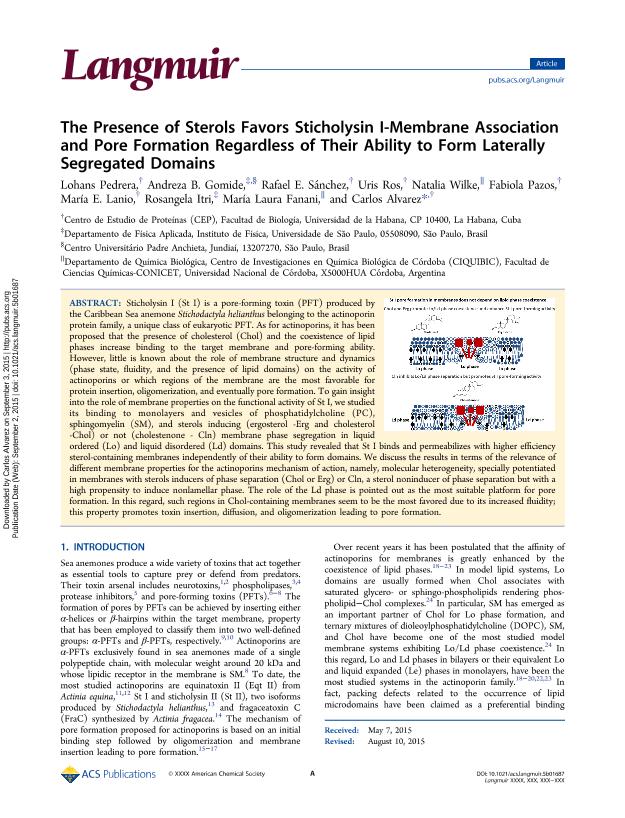Mostrar el registro sencillo del ítem
dc.contributor.author
Pedrera Puentes, Lohans
dc.contributor.author
Gomide, Andreza. B.
dc.contributor.author
Sanchez, Rafael E.
dc.contributor.author
Ros Quincoces, Uris
dc.contributor.author
Wilke, Natalia

dc.contributor.author
Pazos, Fabiola
dc.contributor.author
Lanio, María E.
dc.contributor.author
Itri, Rosangela
dc.contributor.author
Fanani, Maria Laura

dc.contributor.author
Álvarez Valcárcel, Carlos Manuel

dc.date.available
2018-07-02T13:52:40Z
dc.date.issued
2015-09
dc.identifier.citation
Pedrera Puentes, Lohans; Gomide, Andreza. B.; Sanchez, Rafael E.; Ros Quincoces, Uris; Wilke, Natalia; et al.; The presence of sterols favors Sticholysin I - membrane association and pore formation regardless of their ability to form laterally segregated domains; American Chemical Society; Langmuir; 31; 36; 9-2015; 9911-9923
dc.identifier.issn
0743-7463
dc.identifier.uri
http://hdl.handle.net/11336/50816
dc.description.abstract
Sticholysin I (St I) is a pore-forming toxin (PFT) produced by the Caribbean Sea anemone Stichodactyla helianthus belonging to the actinoporin protein family, a unique class of eukaryotic PFT. As for actinoporins, it has been proposed that the presence of cholesterol (Chol) and the coexistence of lipid phases increase binding to the target membrane and pore-forming ability. However, little is known about the role of membrane structure and dynamics (phase state, fluidity, and the presence of lipid domains) on the activity of actinoporins or which regions of the membrane are the most favorable for protein insertion, oligomerization, and eventually pore formation. To gain insight into the role of membrane properties on the functional activity of St I, we studied its binding to monolayers and vesicles of phosphatidylcholine (PC), sphingomyelin (SM), and sterols inducing (ergosterol -Erg and cholesterol -Chol) or not (cholestenone - Cln) membrane phase segregation in liquid ordered (Lo) and liquid disordered (Ld) domains. This study revealed that St I binds and permeabilizes with higher efficiency sterol-containing membranes independently of their ability to form domains. We discuss the results in terms of the relevance of different membrane properties for the actinoporins mechanism of action, namely, molecular heterogeneity, specially potentiated in membranes with sterols inducers of phase separation (Chol or Erg) or Cln, a sterol noninducer of phase separation but with a high propensity to induce nonlamellar phase. The role of the Ld phase is pointed out as the most suitable platform for pore formation. In this regard, such regions in Chol-containing membranes seem to be the most favored due to its increased fluidity; this property promotes toxin insertion, diffusion, and oligomerization leading to pore formation.
dc.format
application/pdf
dc.language.iso
eng
dc.publisher
American Chemical Society

dc.rights
info:eu-repo/semantics/openAccess
dc.rights.uri
https://creativecommons.org/licenses/by-nc-sa/2.5/ar/
dc.subject
Actioporins
dc.subject
Lipid Monolayers
dc.subject
Liquid - Ordered Domains
dc.subject
Giant Unilamellar Vesicles
dc.subject.classification
Otras Ciencias Biológicas

dc.subject.classification
Ciencias Biológicas

dc.subject.classification
CIENCIAS NATURALES Y EXACTAS

dc.title
The presence of sterols favors Sticholysin I - membrane association and pore formation regardless of their ability to form laterally segregated domains
dc.type
info:eu-repo/semantics/article
dc.type
info:ar-repo/semantics/artículo
dc.type
info:eu-repo/semantics/publishedVersion
dc.date.updated
2018-06-29T16:43:39Z
dc.identifier.eissn
1520-5827
dc.journal.volume
31
dc.journal.number
36
dc.journal.pagination
9911-9923
dc.journal.pais
Estados Unidos

dc.journal.ciudad
Washington
dc.description.fil
Fil: Pedrera Puentes, Lohans. Universidad de La Habana; Cuba
dc.description.fil
Fil: Gomide, Andreza. B.. Universidade de Sao Paulo; Brasil
dc.description.fil
Fil: Sanchez, Rafael E.. Universidad de La Habana; Cuba
dc.description.fil
Fil: Ros Quincoces, Uris. Universidad de La Habana; Cuba
dc.description.fil
Fil: Wilke, Natalia. Consejo Nacional de Investigaciones Científicas y Técnicas. Centro Científico Tecnológico Conicet - Córdoba. Centro de Investigaciones en Química Biológica de Córdoba. Universidad Nacional de Córdoba. Facultad de Ciencias Químicas. Centro de Investigaciones en Química Biológica de Córdoba; Argentina
dc.description.fil
Fil: Pazos, Fabiola. Universidad de La Habana; Cuba
dc.description.fil
Fil: Lanio, María E.. Universidad de La Habana; Cuba
dc.description.fil
Fil: Itri, Rosangela. Universidade de Sao Paulo; Brasil
dc.description.fil
Fil: Fanani, Maria Laura. Consejo Nacional de Investigaciones Científicas y Técnicas. Centro Científico Tecnológico Conicet - Córdoba. Centro de Investigaciones en Química Biológica de Córdoba. Universidad Nacional de Córdoba. Facultad de Ciencias Químicas. Centro de Investigaciones en Química Biológica de Córdoba; Argentina
dc.description.fil
Fil: Álvarez Valcárcel, Carlos Manuel. Universidad de La Habana; Cuba
dc.journal.title
Langmuir

dc.relation.alternativeid
info:eu-repo/semantics/altIdentifier/doi/http://dx.doi.org/10.1021/acs.langmuir.5b01687
dc.relation.alternativeid
info:eu-repo/semantics/altIdentifier/url/https://pubs.acs.org/doi/10.1021/acs.langmuir.5b01687
Archivos asociados
